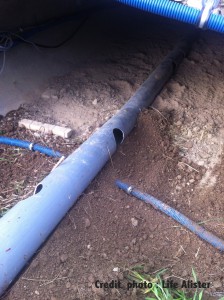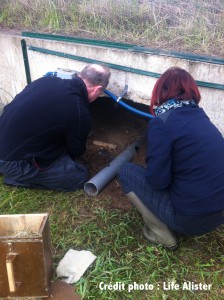How can we improve the effectiveness of wildlife passages,…
7 décembre 2015… which are often traps for European Hamsters and small animals in general?
The reconnection of zones in which the European Hamster is present requires wildlife passages
Fragmentation of the habitat of the European Hamster and urban sprawl are two threats for the survival of the species. Wildlife passages are a solution to mitigate some adverse effects of this fragmentation. Experiments, however, carried out on wildlife passages equipped with video surveillance and photo traps have shown that some predators, especially wild cats, hunt small mammals at the entrance of these wildlife passages.
In the framework of LIFE ALISTER, an action led by the CNRS* is aimed at proposing innovative solutions to minimise predation risks the European Hamster has when crossing through these passages. “Refuge” devices will be put in place in existing wildlife passages, which will increase their use by small animals in plains whilst making the passage for prey animals, such as the European Hamster, much more secure.
An anti-predation tube, an idea from the CNRS
Tests were carried out in controlled conditions, in the CNRS’s animal quarters, and are currently underway in semi-natural conditions, in an paddock built over a wildlife crossing that goes under the Piémont Dual Carriageway, called the “VRPV Paddock,” with hamsters that live in the paddock and “test” hamsters that are released for a night.
 In laboratory conditions, several shapes and sizes of tubes, which will be used as a refuge in wildlife passages, were tested with the hamsters in order to find the best compromise in terms of prey-predator accessibility. The size of openings on the side of the protective tube must allow hamsters to enter quickly whilst preventing their main predators from following them easily. The European Hamsters’ perception and reactions will also be tested through the presence of a predator in a cage.
In laboratory conditions, several shapes and sizes of tubes, which will be used as a refuge in wildlife passages, were tested with the hamsters in order to find the best compromise in terms of prey-predator accessibility. The size of openings on the side of the protective tube must allow hamsters to enter quickly whilst preventing their main predators from following them easily. The European Hamsters’ perception and reactions will also be tested through the presence of a predator in a cage.
These experiments will take place in the VRPV paddock, in a “test” wildlife crossing, with video and photo surveillance. The “anti-predation tube”, with holes every 50 cm and just large enough to allow a European Hamster to enter, will be on the ground along the entire passage. Research experts will study the behaviour of European Hamsters entering spontaneously or not, into the passage.
Different tests will be carried out with and without the “anti-predation tube” in the passage, and with and without a caged predator in the passage, in order to better understand how European Hamsters use the passage and tube.
For species such as ermines and weasels that are small enough to enter the “anti-predation tube”, tests will check whether this device doesn’t make things easier for them.
Expected results
CNRS research experts have already observed many hamsters spontaneously crossing through the paddock, and since the end of summer, they have been observing the behaviour of “test” hamsters, placed for 24 hours in the paddock. Every morning, these hamsters are captured again, and experts have already noted that they make good use of the “anti-predation tube” to escape from the scientists. The analysis of photos (several hundred per night) and video surveillance, (4 cameras operating 24/7), will begin this winter.
The goal of this action is to draw up rules defining how to build systems that European Hamsters can use to cross road infrastructures whilst mitigating predation risks.
These recommendations will be transmitted to authorities in charge of urban planning and road infrastructures all throughout Europe where this species is present.
*Research carried out by Mathilde Tissier (a doctoral student funded by LIFE Alister), supervised by Yves Handrich IPHC – CNRS working

![Congratulations Nathalie Arnold, a Chevalier de l’ordre du Mérite Agricole [A Knight of Agricultural Merit].](https://www.grand-hamster-alsace.eu/wp-content/uploads/2016/12/medaille-120x100.png)
